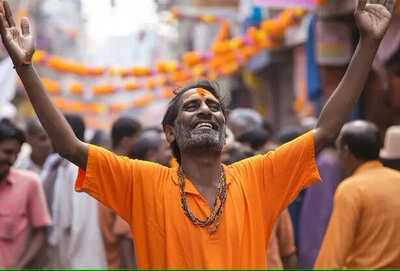
“गङ्गा च यमुना चैव गोदावरी सरस्वती।
नर्मदा सिन्धु कावेरी जलेऽस्मिन्सन्निधिं कुरु॥”
"May the sacred rivers—Ganga, Yamuna, Godavari, Saraswati, Narmada, Sindhu, and Kaveri; be present in this water."
Pilgrimage in India is never just about walking to a temple. It is about walking into yourself. The Char Dham Yatra, the four great journeys mapped by Adi Shankaracharya across the corners of India, has long been called the road to liberation. But hidden within it is something even more profound: the power to be reborn without dying.
For Hindus, rebirth usually belongs to the cycle of samsara. You die, you are born again, and life goes on. Yet the sages said that some places are so charged with divine presence that you can be reborn here and now. The Char Dham: Badrinath, Rameswaram, Dwarka, and Jagannath Puri, are not just temples. They are gateways where the soul sheds its old skin and returns to life with fresh light.
1. Badrinath – Awakening in the Himalayas
 Yatra offers emotional healing, mental strength, and spiritual connection Badrinath, perched among the snow peaks of Uttarakhand, is the northern doorway of the Char Dham. Dedicated to Lord Vishnu as Badrinarayan, it stands beside the Alaknanda River where sages once meditated in silence. Pilgrims begin their journey here by dipping in the steaming Tapt Kund, feeling the body shiver against the cold winds of the Himalayas. That moment itself feels like a death and a birth-the old fatigue is gone, the senses awaken, and the heart turns to Vishnu. In the temple, as the black stone image of Badrinarayan is revealed, one feels stripped of lifetimes of burdens. The mind clears, the ego softens, and what remains is the sense of a new beginning. Badrinath is not about escaping life, but about seeing it anew, with a soul reborn in clarity.
Yatra offers emotional healing, mental strength, and spiritual connection Badrinath, perched among the snow peaks of Uttarakhand, is the northern doorway of the Char Dham. Dedicated to Lord Vishnu as Badrinarayan, it stands beside the Alaknanda River where sages once meditated in silence. Pilgrims begin their journey here by dipping in the steaming Tapt Kund, feeling the body shiver against the cold winds of the Himalayas. That moment itself feels like a death and a birth-the old fatigue is gone, the senses awaken, and the heart turns to Vishnu. In the temple, as the black stone image of Badrinarayan is revealed, one feels stripped of lifetimes of burdens. The mind clears, the ego softens, and what remains is the sense of a new beginning. Badrinath is not about escaping life, but about seeing it anew, with a soul reborn in clarity.
2. Rameswaram – Washing Away Karma
 In the far south, where the land dissolves into the sea, lies Rameswaram, the place where Lord Rama is believed to have prayed to Shiva before crossing into Lanka. The temple here is less about grandeur and more about cleansing. Its 22 sacred wells are famous: each filled with water of different taste and quality, each a ritual station of purification. Pilgrims bathe in them one by one, until body and mind feel emptied of all the dust they carried. By the time they step before the lingam of Shiva, they stand lighter, freer, reborn. Rameswaram is where karma loosens its grip. The past no longer feels like a chain; it becomes water flowing away. The rebirth here is one of action, the courage to step back into life unburdened.
In the far south, where the land dissolves into the sea, lies Rameswaram, the place where Lord Rama is believed to have prayed to Shiva before crossing into Lanka. The temple here is less about grandeur and more about cleansing. Its 22 sacred wells are famous: each filled with water of different taste and quality, each a ritual station of purification. Pilgrims bathe in them one by one, until body and mind feel emptied of all the dust they carried. By the time they step before the lingam of Shiva, they stand lighter, freer, reborn. Rameswaram is where karma loosens its grip. The past no longer feels like a chain; it becomes water flowing away. The rebirth here is one of action, the courage to step back into life unburdened.
3. Dwarka – Rediscovering Devotion
 On the western coast, Dwarka rises where the sea meets the land, echoing with the memory of Krishna’s kingdom. For devotees, this is not just a place of history but a place where the heart itself is reborn. The ritual begins at the Gomti River, where pilgrims bathe before ascending the temple steps. The act is simple, but in it lies a symbolic washing away of distractions and doubts. Inside the temple, as the deity of Dwarkadhish appears in grandeur, something shifts within the devotee. Love feels new, surrender feels effortless, and faith feels alive again. Dwarka does not change the body, it changes the heart. To leave here is to carry devotion as if it were discovered for the very first time.
On the western coast, Dwarka rises where the sea meets the land, echoing with the memory of Krishna’s kingdom. For devotees, this is not just a place of history but a place where the heart itself is reborn. The ritual begins at the Gomti River, where pilgrims bathe before ascending the temple steps. The act is simple, but in it lies a symbolic washing away of distractions and doubts. Inside the temple, as the deity of Dwarkadhish appears in grandeur, something shifts within the devotee. Love feels new, surrender feels effortless, and faith feels alive again. Dwarka does not change the body, it changes the heart. To leave here is to carry devotion as if it were discovered for the very first time.
4. Jagannath Puri – Renewal in the Chariot of Time
 On the eastern shore of Odisha stands Jagannath Puri, a temple unlike any other. Here Krishna appears as Jagannath, along with his siblings Balabhadra and Subhadra, in forms carved of wood. Every 12 to 19 years, these deities are replaced in a ritual called Nabakalebara—the “new body.” Even the gods here embrace rebirth, teaching devotees that life is not permanence but renewal. Nowhere is this felt more strongly than during the Rath Yatra, when the deities are pulled out in massive chariots by thousands of hands. To see Jagannath on the chariot is to feel that time itself is moving forward, carrying you into a new cycle. The rebirth here is one of spirit-an acceptance that change is not to be feared but celebrated.
On the eastern shore of Odisha stands Jagannath Puri, a temple unlike any other. Here Krishna appears as Jagannath, along with his siblings Balabhadra and Subhadra, in forms carved of wood. Every 12 to 19 years, these deities are replaced in a ritual called Nabakalebara—the “new body.” Even the gods here embrace rebirth, teaching devotees that life is not permanence but renewal. Nowhere is this felt more strongly than during the Rath Yatra, when the deities are pulled out in massive chariots by thousands of hands. To see Jagannath on the chariot is to feel that time itself is moving forward, carrying you into a new cycle. The rebirth here is one of spirit-an acceptance that change is not to be feared but celebrated.
The Gift of Rebirth in This LifeThe Char Dham are not just four temples at the edges of India. They are four states of transformation. Badrinath awakens wisdom, Rameswaram washes away karma, Dwarka renews devotion, and Puri teaches the joy of renewal. Together they allow the pilgrim to live a rebirth without leaving the body behind.
In a world where people wait for death to free them, the Char Dham whispers another truth: that freedom is possible now. To walk these paths is to die to the old self and to rise again with the clarity of the Himalayas, the purity of southern waters, the devotion of Krishna’s city, and the renewal of Jagannath’s chariot. Death may come when it must—but rebirth is already here, in every step of the Char Dham Yatra.
-
The Father On OTT: Where To Watch Academy Award Winner Anthony Hopkins' Film

-
TVS Orbiter vs Ola S1 X: Which budget electric scooter to opt for?

-
Japan Mobility Show 2025: Honda to showcase an array of prototypes and production models

-
Ganpati Aarti At Salman Khan’s Home: Sonakshi & Zaheer Join The Festive Spirit; WATCH

-
'Jugaad Aayog': Akhilesh Hits Out At EC Over SIR In Bihar, Amit Shah Targets 'Infiltrator-Friendly' Leaders
